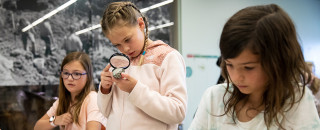Junior Science Academy Class Descriptions
4th Grade Classes
Artifacts and Culture of Ancient Problem Solvers
- Observe, draw, and analyze the function of archaeological artifacts
- Analyze classroom artifacts in relation to museum collections and learn what conclusions archaeologists reached regarding students’ artifacts.
- Compare and contrast Ancestral Puebloan footwear or pottery with Freemont footwear and pottery and create arguments explaining these differences.
- Participate in a trade game which models ancient, pre-European trade networks found though out the Southwestern United States.
- This class encourages use of Science and Engineering Practices while exploring Social Studies Standard I, Objectives 1&2, and Standard II, Objective 1
Biology: Structure and Function in Living Organisms
- Compare and contrast yarrow plant structures across elevations.
- Observe bird models and draw conclusions about habitat and diet based on visible structures.
- Analyze invertebrate specimens with microscopes to create scientific drawings and draw conclusions regarding the function of visible structures.
- This class uses Museum quality specimens to further understanding of SEEd standards 4.1.1 and 4.1.2
Energy Transfer and Water
- This class will be taught September-October and March-May weather permitting.
- Use engineering principles to create a pump out of pvc pipe and test it with various iterations.
- Investigate the types of energy at work in a pump.
- Explain the cause and effect between the speed of pumping and amount of water transferred via computational thinking and flow rate.
- Analyze data sets regarding water usage in the state of Utah.
- This class uses tools and data to increase understanding of SEEd standards 4.2.1 and Standard 4.2.4
Fossils: Stability and Change in the Fossil Record
- Observe and record the structures of fossils to better understand what a fossil is
- Compare the patterns in Green River leaf fossils to modern leaves to determine the environment in Utah 52 million years ago
- Compare and contrast trilobite fossils to better understand stability and change in an organism over time
- Observe the ceratopsian wall to develop conclusions about why an organism might change
- This class allows students close interaction with museum quality fossils to improve their comprehension of SEEd standards 4.1.3 and 4.1.4
Making Waves
- Explore the difference between amplitude and wavelength using our bodies as the model.
- Manipulate Slinkys and interpret data about the patterns of energy they display.
- Develop a conclusion about which materials effectively block the energy from radio waves.
- This class uses data and hand on activities to deepen students comprehension of SEED standards 4.3.1 and 4.3.3
5th Grade Classes
*New* Decomposers in Ecosystems
- Observe “red wiggler” worms to understand how their adaptations make them suited for their role as decomposers and guardians of the soil.
- Analyze the soil using soil meters to asses moisture, nutrients, pH, and light levels.
- Compare plants fertilized and not fertilized by worm castings to build conclusions about the nutrients they replace in the soil.
- Track NHMU field trip food waste diverted from landfills and replaced as soil and evaluate the effectiveness of this solution to waste.
- This class uses Museum exhibits, data, and tools to help students comprehension of SEEd Standards 5.3.3 and 5.3.4
Earth's Systems: Using Models to Find Solutions
- Analyze and interpret patterns in maps and weather data to understand local trends in temperature inversion.
- Learn what is in our atmosphere and how those various molecules react to temperature changes.
- Investigate a model to understand how convection and inversion work in the atmosphere.
- Understand how our landscape and naturally occurring weather patterns in the atmosphere can impact particulate matter in the air.
- Analyze the system model of a Salt Lake inversion day and design solutions to the problem.
- This class uses Museum exhibits, data, and tools to help students comprehension of SEEd Standards 5.1.4 and 5.1.5
